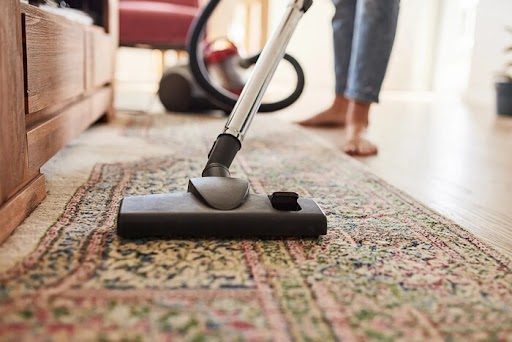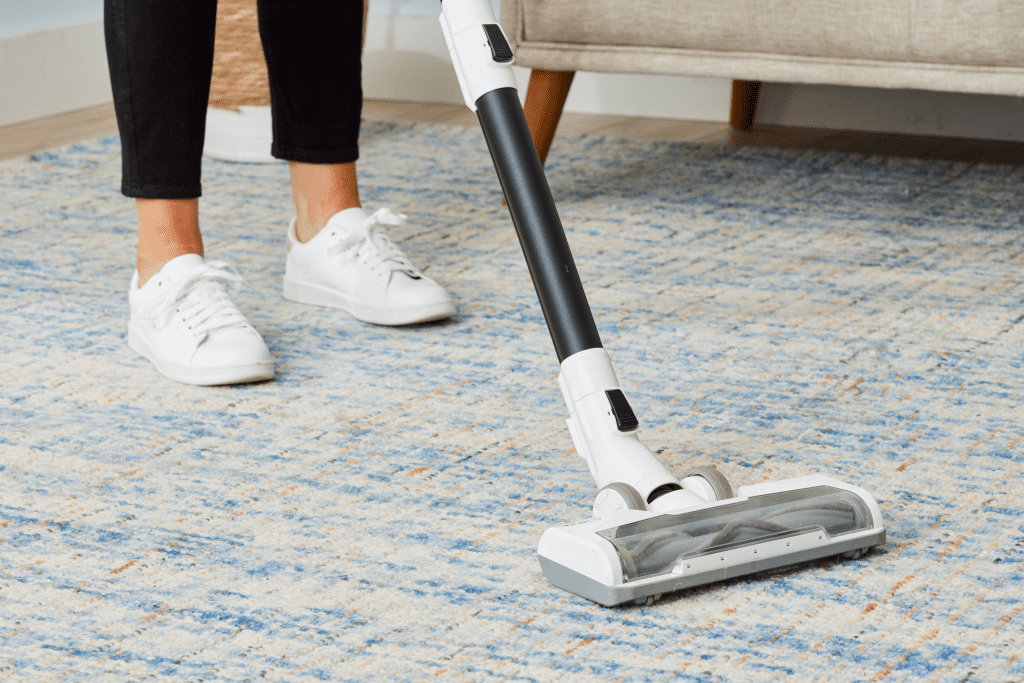Vacuuming your carpets might seem like a simple chore, but doing it correctly can make a significant difference in how clean your carpets stay and how long they last. In this comprehensive guide, we’ll walk you through the best practices for vacuuming your carpets effectively, ensuring they remain fresh, dirt-free, and looking their best for years to come.
1. Prepare the Area: Setting the Stage for Effective Vacuuming
Clear the Floor of Clutter

Before you even turn on your vacuum, it’s crucial to clear the area of any small objects, toys, or clutter that might be scattered across your carpet. Not only does this prevent these items from getting stuck in your vacuum, but it also ensures that you can clean every inch of your carpet without missing spots.
Dust Furniture and Fixtures First
Dust particles from furniture and fixtures can easily settle on your freshly vacuumed carpet if not addressed beforehand. Make sure to dust off these surfaces before you start vacuuming. This way, you won’t have to re-vacuum areas that collect dust during the cleaning process.
2. Choose the Right Vacuum: Matching the Tool to the Job
Adjust the Vacuum Height for Your Carpet Type
Not all carpets are created equal, and neither are all vacuums. If your vacuum has an adjustable height setting, make sure it’s properly adjusted for your specific carpet type. If the setting is too high, the vacuum might not pick up all the dirt. If it’s too low, it could make moving the vacuum difficult and potentially damage the carpet fibers.
Select the Appropriate Attachments
For thicker carpets or rugs, using a beater bar or a rotating brush attachment can help lift dirt and debris more effectively. However, for delicate or looped carpets, it’s better to use a suction-only attachment to avoid damaging the fibers.

3. Vacuum Slowly and Thoroughly: Don’t Rush the Process
Start in a Corner and Work Your Way Out
Begin vacuuming in one corner of the room and systematically work your way out. This method ensures that you cover every part of the carpet without stepping on freshly cleaned areas.
Use Overlapping Strokes for Complete Coverage
Vacuuming in straight lines with overlapping strokes helps ensure that no area is left untouched. Additionally, vacuuming in different directions (first vertically, then horizontally) can help lift dirt from all angles, giving your carpet a more thorough clean.
Go Slow for a Deep Clean
Take your time when vacuuming. Moving the vacuum too quickly over the carpet reduces its effectiveness. By vacuuming slowly, you allow the vacuum to pick up more dirt and dust, especially in thicker carpets where debris can settle deep within the fibers.
4. Pay Attention to High-Traffic Areas: Focus Where It’s Needed Most
Extra Care for Entryways and Hallways

High-traffic areas like entryways and hallways tend to accumulate more dirt and require more attention. These areas should be vacuumed more frequently and thoroughly than other parts of your home.
Double Pass for a Deeper Clean
For these high-traffic zones, it’s a good idea to make two or more passes with the vacuum to ensure all the dirt and debris are picked up. This extra effort helps maintain the cleanliness and longevity of your carpets.
5. Empty the Vacuum Bag or Canister Regularly: Maintain Strong Suction
Check the Bag or Canister Often
A full vacuum bag or canister can significantly reduce your vacuum’s efficiency. To maintain strong suction power, it’s recommended to empty the bag or canister when it’s about two-thirds full. This small step can make a big difference in how effectively your vacuum cleans.
Clean or Replace Filters Regularly
Filters play a crucial role in your vacuum’s performance. Clogged filters can reduce suction and recirculate dust back into the air. Clean or replace your vacuum’s filters according to the manufacturer’s instructions to keep it functioning at its best.
6. Vacuum Frequently: Consistency Is Key
Stick to a Regular Vacuuming Schedule
:max_bytes(150000):strip_icc()/how-to-deep-clean-carpet-4846968-hero-3b787e45708448d88049ee2a2c5a05af.jpg)
To keep your carpets in top condition, vacuum high-traffic areas at least twice a week and other areas once a week. Regular vacuuming prevents dirt from becoming deeply embedded in the carpet fibers, making it easier to maintain overall cleanliness.
Spot Vacuum When Necessary
If you notice a spill or a particularly dirty spot, don’t wait until your next scheduled vacuuming session. Vacuum it immediately to prevent stains from setting in or dirt from spreading.
7. Maintain Your Vacuum: Keep Your Tool in Top Shape
Regularly Check for Blockages
Over time, blockages can form in your vacuum’s hose or attachments, reducing suction power. Regularly inspect your vacuum for any blockages and clear them to ensure it works efficiently.
Replace Worn-Out Parts
Your vacuum’s performance can decline if parts like brushes or belts wear out. Keep your vacuum in good condition by replacing these components as needed. This simple maintenance can extend the life of your vacuum and improve its cleaning ability.
Conclusion
Proper vacuuming is more than just running a machine over your carpets. By following these steps—preparing the area, choosing the right vacuum, vacuuming thoroughly, focusing on high-traffic areas, maintaining your vacuum, and vacuuming frequently—you can keep your carpets clean, fresh, and in good condition for years to come. Regular, effective vacuuming not only enhances the appearance of your carpets but also contributes to a healthier living environment by reducing dust and allergens.


